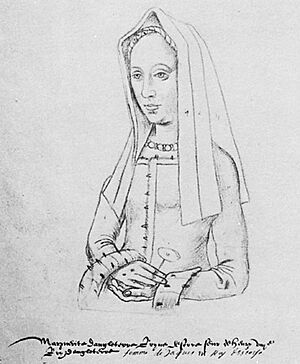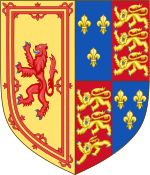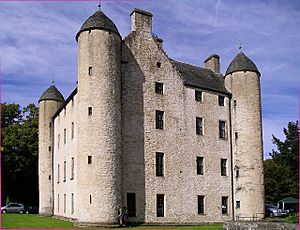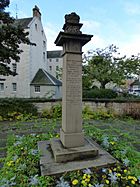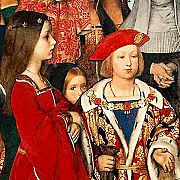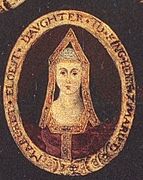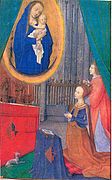Margaret Tudor facts for kids
Quick facts for kids Margaret Tudor |
|
|---|---|
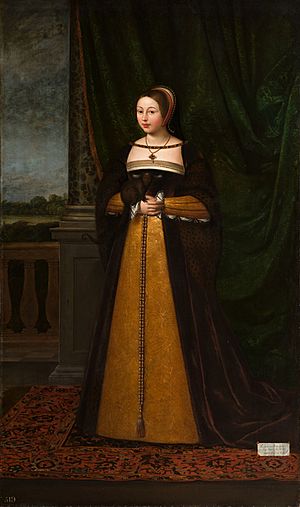
Portrait by Daniel Mytens, c. 1620–1638
|
|
| Queen consort of Scotland | |
| Tenure | 8 August 1503 – 9 September 1513 |
| Coronation | 8 August 1503 |
| Regent of Scotland | |
| Regency | 1513–1515 1524–1525 |
| Monarch | James V |
| Born | 28 November 1489 Palace of Westminster, London, England |
| Died | 18 October 1541 (aged 51) Methven Castle, Perthshire, Scotland |
| Burial | Perth Charterhouse |
| Spouse |
|
| Issue |
|
| House | Tudor |
| Father | Henry VII of England |
| Mother | Elizabeth of York |
| Religion | Roman Catholicism |
Margaret Tudor (born 28 November 1489 – died 18 October 1541) was the Queen of Scotland from 1503 to 1513. She became queen by marrying King James IV. After his death, she became a regent for her young son, King James V. A regent is someone who rules a country when the king or queen is too young or unable to rule.
Margaret was the oldest daughter of King Henry VII of England and Elizabeth of York. She was also the older sister of King Henry VIII.
Margaret married James IV when she was 13 years old. This marriage was part of a peace agreement between England and Scotland. They had six children together, but only one lived to be an adult. Margaret's marriage helped connect the royal families of England and Scotland. This connection later led to the Union of the Crowns, when one king ruled both countries.
After James IV died in battle in 1513, Margaret became regent for their son, James V. Some Scottish nobles wanted to replace her with John, Duke of Albany, who was a close male relative of the young king. To find support, Margaret married Archibald Douglas, 6th Earl of Angus in 1514. This made many nobles unhappy, and she was replaced as regent by Albany.
In 1524, Margaret, with help from the Hamilton family, removed Albany from power. She was then recognized by the Scottish Parliament as regent again. Later, she became the main advisor to King James V. After divorcing Angus in 1527, Margaret married her third husband, Henry Stewart, 1st Lord Methven. Through her first two marriages, Margaret was the grandmother of both Mary, Queen of Scots, and Mary's second husband, Lord Darnley.
Contents
Early Life and Royal Connections
Margaret was born on November 28, 1489, at the Palace of Westminster in London. Her parents were King Henry VII of England and Elizabeth of York. She was their second child and first daughter. Her brothers and sisters included Arthur, Prince of Wales, who would have been king, the future King Henry VIII, and Mary, who became Queen of France for a short time.
Margaret was named after her grandmother, Lady Margaret Beaufort. In 1502, Scotland and England signed the Treaty of Perpetual Peace. This was the first peace agreement between the two countries in over 170 years. Margaret's marriage to James IV was part of this treaty. Even though she was still a child, she was called the "Queen of Scots" after this agreement.
A Royal Wedding Journey
Margaret's wedding to James IV happened by proxy on January 25, 1503, at Richmond Palace. This means someone stood in for the Scottish king during the ceremony. The Earl of Bothwell acted as the king's representative. After the ceremony, there were big celebrations and knightly games.
Margaret received many new clothes for her wedding. Her royal bed curtains were made of fancy Italian silk and decorated with red roses. In May 1503, James IV gave her lands and castles in Scotland. These included Methven Castle, Stirling Castle, Doune Castle, Linlithgow Palace, and Newark Castle.
Later in 1503, Margaret traveled to Scotland. It was a grand journey north. She left Richmond Palace on June 27 with her father, King Henry VII. They traveled to Collyweston and York. On August 1, 1503, she crossed the border into Scotland at Berwick-upon-Tweed. The Scottish court met her at Lamberton.
At Dalkeith Palace, King James IV came to visit her. He even came to comfort her after a stable fire killed some of her favorite horses. On August 8, 1503, the actual wedding ceremony took place at Holyrood Abbey. Two days later, Margaret attended mass at St Giles' Cathedral, which was her first public event as queen.
Margaret's Children
Margaret and King James IV had six children together. Sadly, only one of them lived past childhood:
- James, Duke of Rothesay (born 1507, died 1508)
- A daughter (born and died 1508)
- Arthur Stewart, Duke of Rothesay (born 1509, died 1510)
- James V (born 1512, died 1542)
- A daughter (born and died 1512)
- Alexander Stewart, Duke of Ross (born 1514, died 1515)
In 1514, Margaret married Archibald Douglas, 6th Earl of Angus. They had one child:
- Margaret Douglas (born 1515, died 1577). She later married Matthew Stewart, 4th Earl of Lennox.
In 1528, Margaret married Henry Stewart, 1st Lord Methven. They had one child:
- Dorothea Stewart (died young)
Life as Queen of Scotland
As queen, Margaret had a household of 24 English servants. These included her cook, chambermaids, musicians, and ladies-in-waiting. Some of her ladies had worked for her mother, Elizabeth of York.
Margaret had some interesting customs. On a special day called Maundy Thursday, she would give gifts to poor women. The number of women matched her age. For example, in 1504, she gave gifts to 15 poor women because she was 15 years old. On New Year's Day, people exchanged gifts. In 1507, James IV gave Margaret a "serpent's tongue," which was actually a shark tooth set in gold. People believed it protected against poison.
Margaret sometimes suffered from nosebleeds. An apothecary (a type of pharmacist) gave her a special stone called a heliotrope to help. She also went on religious journeys, called pilgrimages. In 1507, she traveled to Whithorn after being sick. She rode a horse with a reindeer pelt on the saddle.
King James IV even named a warship after her, called the Margaret. The peace treaty between England and Scotland did not last long. When Margaret's brother, Henry VIII, became king of England in 1509, he soon went to war with France. Scotland was France's old ally. In 1513, James IV invaded England to help France. He died in the Battle of Flodden. Margaret had been against the war. In his will, James IV named her as regent for their young son, James V, as long as she remained a widow.
Regency and Second Marriage Challenges
After the Battle of Flodden, the Scottish Parliament confirmed Margaret as regent. However, it was unusual for a woman to hold such power. Also, Margaret was the sister of the enemy king, Henry VIII, which made things harder. Soon, a group of nobles who supported France wanted to replace her. They wanted John Stewart, 2nd Duke of Albany, to be regent instead. Albany had grown up in France and was seen as a strong link to Scotland's alliance with France.
Margaret tried to handle the situation calmly. By July 1514, she helped Scotland and France make peace with England. But she made a big mistake when looking for allies among the Scottish nobles. She became very attracted to Archibald Douglas, 6th Earl of Angus. Even his own uncle called him a "young witless fool."
Margaret and Angus secretly married on August 6, 1514. This marriage upset other noble families. It also made the pro-French group stronger. According to her late husband's will, Margaret lost her position as regent when she remarried. Before the month ended, she had to agree to Albany becoming regent.
In September, the Scottish council decided she also lost her right to care for her sons. Margaret refused and took the princes to Stirling Castle. She even created a secret code for letters to Henry VIII. Letters signed "Your loving sister, Margaret R" would be real, meaning she was not being forced to write them.
Escape to England and a New Child
Albany arrived in Scotland in May 1515 and became regent in July. His first goal was to get custody of James and Alexander, Margaret's sons. This was important for his power. Margaret finally gave up her sons at Stirling in August. With her sons in Albany's care, Margaret, who was expecting a child with Angus, went to Edinburgh. Her brother, Henry VIII, had been telling her to flee to England with her sons. She had refused, fearing it would make James lose his Scottish crown.
However, once her sons were with Albany, Margaret secretly accepted her brother's offer of safety in England. She was pregnant and worried for her life under the Scottish council's rule. As queen dowager, she even had to ask for permission to travel. She got permission to go to Linlithgow Palace for her delivery.
She escaped to Tantallon Castle and then crossed the border into England. She left many valuable jewels behind. Margaret was welcomed by Thomas Dacre, Henry VIII's officer in the border region. She was taken to Harbottle Castle in Northumberland. There, in early October, she gave birth to her daughter, Margaret Douglas. This Margaret later became the mother of Henry Stuart, Lord Darnley, who was the second husband of Mary, Queen of Scots.
While in England, Margaret learned that her younger son, Alexander, had died. Some people hinted that Albany was responsible. But Margaret refused to believe this. She said if Albany truly wanted the throne for himself, he would have tried to kill James, not Alexander. It was also around this time that she started to understand Angus better. He went back to Scotland to make peace with Albany, which surprised Margaret. When Henry VIII heard that Angus would not join Margaret in London, he said, "Done like a Scot." But Angus's power and wealth were in Scotland, and leaving the country could mean losing everything.
Politics and a Troubled Marriage
Margaret was welcomed by Henry VIII in London. She stayed at Scotland Yard, which was the old London home of Scottish kings. In 1517, after a year in England, she returned to Scotland. A peace agreement had been made by Albany, Henry, and Cardinal Wolsey. Albany was in France, but his deputy and her husband, Angus, met her at the border.
Margaret and Angus were briefly reunited, but their relationship quickly worsened. She found out that while she was in England, Angus had been living with another woman. Even worse, he had been spending her money. Margaret wanted a divorce, but Henry VIII was against divorce. He also saw Angus as a useful ally against Albany and the pro-French group.
Angry with Angus, Margaret grew closer to Albany's group. She joined others in asking Albany to return from France. Albany suggested that Margaret should become regent again. The fight between Margaret and Angus became a major part of Scottish politics for the next three years. It was also complicated by a feud between Angus and James Hamilton, 1st Earl of Arran. Margaret often switched sides between them.
Albany finally returned to Scotland in November 1521. Margaret welcomed him warmly. People soon whispered that their good relationship was more than just political. Angus went into exile. Albany, with Margaret's help, worked to bring order back to the country. Albany was helpful to Margaret because he had influence in Rome, which could help her get a divorce. Angus and his friends spread rumors that Margaret and Albany were lovers. But their relationship was only about what they could gain from each other.
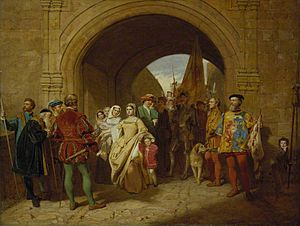
Margaret's Bold Move
Margaret always wanted a better understanding between England and Scotland. She needed an alliance with Albany and the French group, especially after the wars with England in the early 1520s. But as soon as Albany left, she started to form her own political group. In 1524, Albany was removed from power in a simple but effective move.
With Albany back in France, Margaret, with help from Arran and the Hamiltons, brought James, who was now 12 years old, from Stirling to Edinburgh. This was a brave and popular action. In August, Parliament declared that the regency was over, and James became the full king. In reality, his mother still guided him. When a church leader named Beaton disagreed, Margaret had him arrested and put in jail. In November, Parliament officially recognized Margaret as the king's main advisor.
Margaret's new alliances upset other noble families. Her situation became harder when her brother, Henry VIII, allowed Angus to return to Scotland. The most damaging thing she did was form a new attachment to Henry Stewart, a younger brother of Lord Avondale.
Stewart was given an important job, which angered the Earl of Lennox and others. Lennox then joined forces with Angus. In November, when Parliament confirmed Margaret's political role, her fight with Angus became very dramatic. When Angus arrived in Edinburgh with armed men, Margaret ordered cannons to be fired at him from Edinburgh Castle and Holyrood Palace. When English ambassadors told her not to attack her husband, she angrily told them to "go home and not meddle with Scottish matters."
Angus left for a while. But under pressure, Margaret finally allowed him to join the council of regency in February 1525. This gave him the power he needed. He took custody of James and refused to give him up. Angus ruled on James's behalf for three years. James's experience during this time made him strongly dislike both the Douglas family and the English.
Divorce and Third Marriage
Margaret tried to resist but had to accept the new political situation. By this time, her desire for a divorce had become her main focus. She even used the false rumor that James IV had not died at Flodden. Despite her bold move in 1524, she kept in touch with Albany, who continued to help her with her divorce in Rome. In March 1527, Pope Clement VII approved her request. Because of political problems in Europe, she did not learn the good news until December. She married Henry Stewart on March 3, 1528. She ignored warnings against the divorce.
In June 1528, James V finally freed himself from Angus's control and began to rule on his own. Margaret and her new husband became the king's main advisors. James made Stewart Lord Methven because of "the great love he bore to his dearest mother." Margaret helped bring about the peace agreement between England and Scotland in May 1534.
Margaret's main goal in her political life was to create a better understanding between England and Scotland. James was suspicious of Henry VIII, especially because Henry continued to support Angus, whom James hated. Even so, in early 1536, Margaret persuaded her son to meet her brother. This was a moment of triumph for her. She wrote to Henry and his chief advisor, Thomas Cromwell, saying it was "by advice of us and no other living person." She hoped for a grand meeting like the Field of Cloth of Gold. She spent a lot of money preparing. But in the end, the meeting did not happen. There were too many objections, and James did not want his mother or anyone else telling him what to do. In a private talk with the English ambassador, William Howard, Margaret showed her disappointment. She said, "I am weary of Scotland." She even shared state secrets with Henry.
Margaret was tired of Scotland, but she was even more tired of Lord Methven. He was proving to be even worse than Angus. He wanted other women and his wife's money. She wanted another divorce, but James prevented it. She believed her husband had bribed James. Margaret often wrote to Henry, complaining about her poverty and asking for money and protection. She wanted an easy life instead of having to "follow her son about like a poor gentlewoman."
In early 1536, Henry VIII sent her money and luxury fabrics. The fabrics were for clothes to welcome her son's bride, Madeleine of Valois. Margaret welcomed Mary of Guise, James's second French bride, to Scotland in June 1538. These two strong women got along well. Mary made sure her mother-in-law, who had made up with Methven, appeared regularly at court. It was reported to Henry that "the young queen was all papist, and the old queen not much less."
Death and Burial
Margaret died at Methven Castle on October 18, 1541. A messenger reported that she had palsy (possibly from a stroke) on Friday and died the following Tuesday. She thought she would get better, so she did not make a will. She sent for King James, who was at Falkland Palace, but he did not arrive in time. Near the end, she wished that the friars with her would help the King and the Earl of Angus make peace. She hoped the King would give her belongings to her daughter, Lady Margaret Douglas. James arrived after her death and ordered her belongings to be packed up for his use.
She was buried at the Perth Charterhouse in Perth. This building was later destroyed during the Scottish Reformation in 1559. The funeral was not as grand as the one for Madeleine of Valois in 1537. However, James V and his household wore expensive black clothes for a period of mourning.
Gallery
-
Detail of Margaret, Henry VIII, and Princess Mary being visited by Erasmus, dated c. 1910, by Frank Cadogan Cowper
-
A depiction of Margaret from a family tree from the reign of her great-grandson, James VI/I of Scotland and England
See also
 In Spanish: Margarita Tudor para niños
In Spanish: Margarita Tudor para niños


